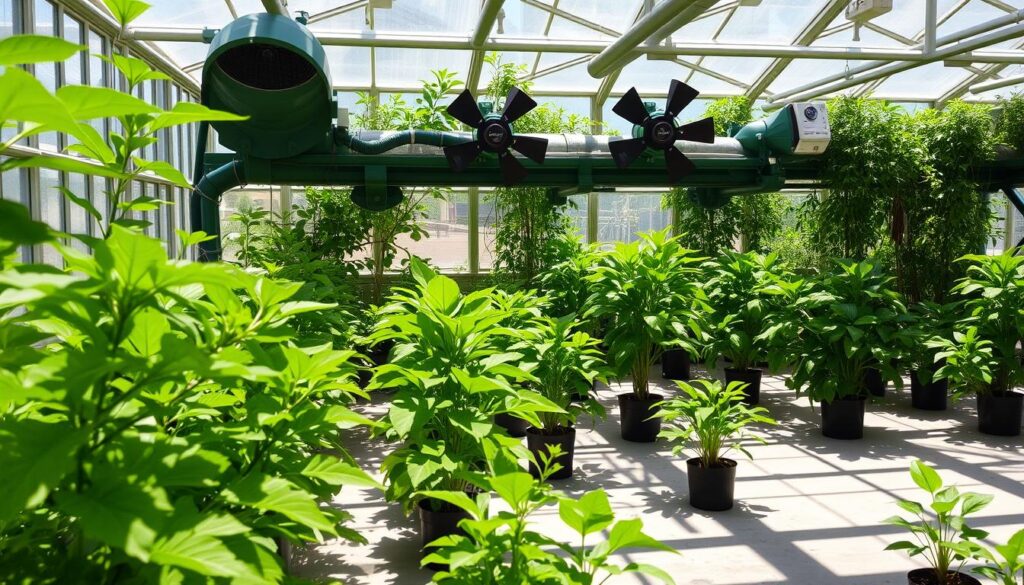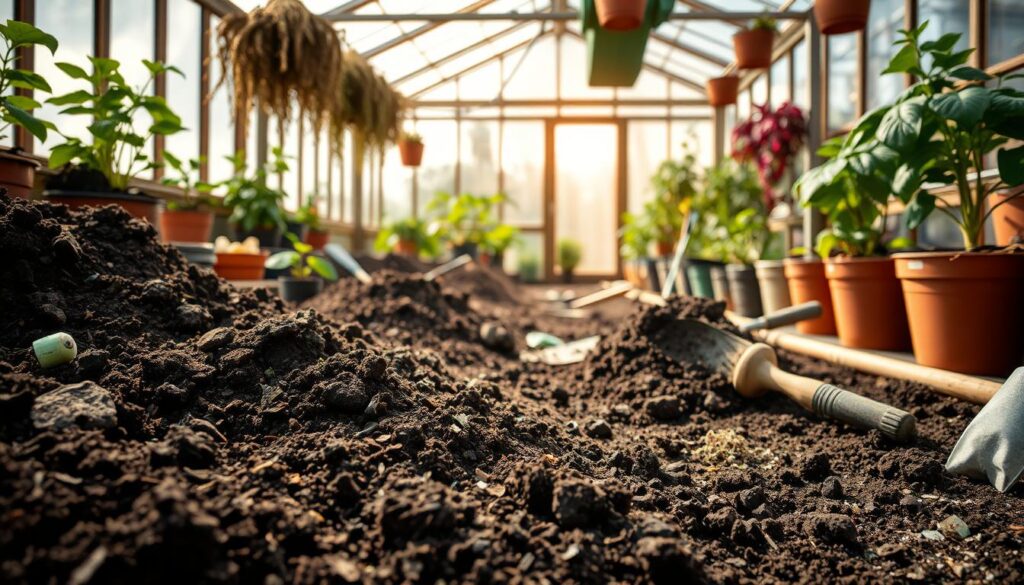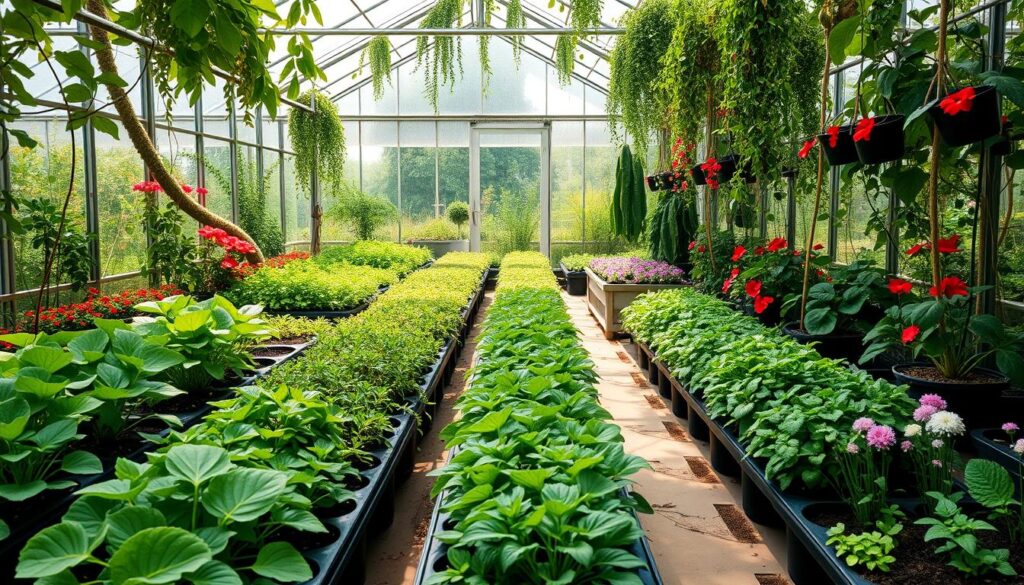As a passionate greenhouse gardener, I’ve found that success goes beyond just knowing plants. Many common mistakes can ruin even the best greenhouse projects. In this article, I’ll share 10 key mistakes beginners should know and how to steer clear of them for a great harvest.
Issues like bad temperature control, not enough air, wrong watering, and poor lighting can harm your plants. By avoiding these greenhouse mistakes, you can create a vibrant, productive indoor space that thrives all year.
Poor Temperature Control and Regulation in Your Greenhouse
Keeping the right temperature in your greenhouse is key for your plants’ health and growth. Good greenhouse temperature control and environmental management can make a big difference. We’ll look at ways to manage heat in summer, keep it warm in winter, and use temperature control equipment effectively.
Managing Heat During Peak Summer
In the hottest summer days, greenhouses can get too warm for your plants. To fight this, think about adding greenhouse cooling systems like fans or evaporative coolers. It’s also smart to check temperature and humidity often to know when to turn on these coolers.
Winter Temperature Maintenance Tips
- Get a good greenhouse heating system, like a space heater, to keep it warm in cold months.
- Insulate your greenhouse well to keep heat in better, which helps your heating system less.
- Use thermal blankets or row covers to shield your plants from harsh winter weather.
Using Temperature Control Equipment Effectively
Using environmental control tech, like thermostats and hygrometers, can really help control your greenhouse’s climate. Make sure to set these tools right and watch them closely to keep your plants at the best temperature and humidity all year.
Achieving the right balance of greenhouse heating and cooling is essential for creating the perfect growing environment for your plants.”
By getting good at controlling temperature in your greenhouse, you’ll be on your way to a thriving garden, no matter the season.
Inadequate Ventilation Systems and Air Circulation
Good ventilation is key for a healthy greenhouse. Without it, you face issues like temperature problems and disease spread. As a gardener, knowing about ventilation is crucial.
Many make the mistake of ignoring ventilation systems. You can use natural and mechanical ways to keep air moving. This includes vents, fans, and climate control. Without these, air can stagnate, causing temperature issues and disease risks.
- Ventilation methods: Natural ventilation, mechanical ventilation, and a combination of both
- Greenhouse ventilation strategies: Proper placement and maintenance of vents, fans, and climate control systems
- Ventilation errors to avoid: Neglecting to install or properly maintain ventilation systems
It’s also important to match ventilation to your greenhouse’s size and climate. A big greenhouse needs better systems than a small one. Without the right plan, air flow and plant health suffer.
| Ventilation Method | Advantages | Disadvantages |
|---|---|---|
| Natural Ventilation |
|
|
| Mechanical Ventilation |
|
|
To get the best ventilation, know your greenhouse’s needs. A good strategy keeps air flowing well. This helps your plants thrive in a healthy environment.

Common Watering Mistakes That Harm Plant Growth
As a passionate greenhouse gardener, I’ve learned that proper watering is key. Many new gardeners make mistakes that harm their plants. Let’s look at these mistakes and how to avoid them.
Signs of Overwatering
Overwatering is a big problem in greenhouses. Signs include yellow or wilting leaves, slow growth, and fungal diseases. A foul smell from the soil is also a bad sign.
It’s important to watch your plants closely. Fix any signs of overwatering quickly to avoid more harm.
Creating an Effective Watering Schedule
Having a good watering schedule is crucial. Consider the plant type, soil, and environment when setting your schedule. Water deeply but less often, rather than lightly and often.
Water Quality Considerations
The water quality in your greenhouse matters a lot. pH, minerals, and contaminants can affect plant health. Test your water regularly and adjust as needed to help your plants grow well.
By avoiding these common mistakes, gardeners can help their plants thrive. A bit of attention to detail can make a big difference in greenhouse gardening.
10 Greenhouse Gardening Mistakes Every Beginner Should Avoid
Starting your greenhouse gardening journey? It’s key to know the common mistakes that can slow you down. By avoiding these errors, you can make sure your greenhouse grows well. In this guide, I’ll share 10 mistakes beginners often make and how to avoid them.
- Improper plant selection: Picking the wrong plants can harm your greenhouse. Make sure to check the light, temperature, and humidity needs of your plants.
- Neglecting temperature control: Keeping the right temperature is crucial for your plants. Don’t let heat get too high in summer or too low in winter.
- Insufficient ventilation: Good air flow is important for healthy plants. It helps prevent bad gases and pests.
- Overwatering or underwatering: Finding the right water balance is hard. But it’s key to avoid root rot or dehydration.
- Ignoring lighting requirements: Plants need the right light to grow well. Not enough light can make them weak and leggy.
These are just a few mistakes beginners often make in greenhouse gardening. By knowing these and taking steps to avoid them, you’ll have a successful greenhouse. With the right knowledge and care, you can create a beautiful indoor garden that brings you joy for years.
Improper Lighting Setup and Management
Proper lighting is key for a successful greenhouse garden. Finding the right mix of natural and artificial light is vital. This balance helps plants grow strong and healthy.
Natural vs Artificial Light Balance
It’s important to understand how natural and artificial light work together. Natural sunlight is the main light source. But, adding grow lights can help plants get enough light all day. Finding the right mix is crucial for healthy plants.
Seasonal Lighting Adjustments
Light needs change with the seasons. In summer, natural light is enough. But in winter, you need more artificial light. Adjusting your lighting with the seasons ensures plants get the right light all year.
Light Intensity Monitoring
Keeping an eye on light levels in your greenhouse is essential. Light meters help track light levels. This lets you adjust your lighting to meet your plants’ needs.
| Lighting Strategies | Greenhouse Lighting Optimization | Lighting Requirements |
|---|---|---|
| Natural sunlight utilization | Balancing natural and artificial light | Tailoring lighting to seasonal changes |
| Supplemental grow light placement | Monitoring light intensity levels | Ensuring adequate light for plant health |

Mastering greenhouse lighting can create a perfect environment for your plants. With the right strategies, your garden will flourish.
Overlooking Soil Quality and Preparation
Greenhouse gardening can be thrilling, but it’s crucial to focus on soil quality and preparation. Good soil management is key for healthy plants. Without it, you might face many problems.
Soil preparation is the first step to a successful greenhouse garden. Good soil quality, nutrient balance, and drainage are vital for a great harvest. Let’s look at why soil preparation is important and common mistakes to avoid.
The Importance of Greenhouse Soil Quality
The soil in your greenhouse affects your plants’ growth and health. Rich, well-draining soil is perfect for plant roots and nutrient uptake. Poor soil can cause stunted growth, nutrient shortages, and disease.
- Soil preparation ensures optimal nutrient balance and pH levels for your plants.
- Well-draining soil prevents waterlogging and root rot, allowing plants to thrive.
- Healthy soil supports a diverse microbial community, which can improve plant resilience.
Common Soil Preparation Mistakes to Avoid
Soil preparation might seem simple, but many gardeners make mistakes. Avoiding these can help your greenhouse garden succeed:
- Failing to amend the soil with organic matter: Compost, peat moss, or other organic additives help improve soil structure, water-holding capacity, and nutrient availability.
- Neglecting to test and adjust the soil pH: Plants thrive best in specific pH ranges, and failing to maintain the optimal pH can lead to nutrient deficiencies.
- Overlooking the importance of soil drainage: Poorly draining soil can cause waterlogging, leading to root rot and other issues.
- Ignoring the need for regular soil testing and replenishment: Greenhouse plants can quickly deplete the soil’s nutrients, requiring periodic testing and amendment.
By focusing on soil preparation and quality, you can create a thriving greenhouse garden. Healthy soil is essential for success in greenhouse gardening.

Plant Spacing and Overcrowding Issues
Proper plant spacing is key in greenhouse gardening. Many new growers forget this. Overcrowding can cause stunted growth, lower yields, and more pests and diseases. We’ll talk about how to space plants right, use vertical space well, and rotate crops for a healthy garden.
Calculating Proper Plant Spacing
Finding the right plant spacing in a greenhouse is tricky. You need to use space well but also give each plant room to grow. Aim for 6-12 inches between plants, based on their size and growth. This prevents overcrowding and helps plants thrive.
Managing Vertical Space
Use vertical space in your greenhouse to grow more plants. Try vertical gardening with trellises, hanging baskets, or tiered shelves. This boosts plant spacing and air flow, reducing overcrowding issues.
Crop Rotation Strategies
- Rotate crops to avoid pests and diseases in the soil.
- Group plants with similar crop planning and crop management needs together.
- Plant a cover crop or green manure between seasons to enrich soil and control weeds.
Using these strategies can help you improve plant spacing, avoid overcrowding, and create a healthy, productive greenhouse.

Neglecting Pest Prevention and Control Measures
Keeping your greenhouse healthy and thriving means watching out for pests. If you ignore pest control and prevention, your plants could suffer. This could ruin your greenhouse gardening plans.
Many gardeners forget to use proactive pest management. It’s better to stop pests before they start. Regular checks, quick action, and greenhouse pest management keep your plants safe and growing well.
- Check your plants often for pest signs like color changes, wilting, or insects.
- Use natural pest repellents like garlic, neem oil, or insecticidal soaps to keep pests away.
- Use physical barriers like row covers or screens to block pests from reaching your plants.
- Keep your greenhouse clean and disinfected to stop pests from breeding.
If pests do show up, act fast. Ignoring pests can let them spread quickly, harming your plants and crops. Use eco-friendly pest control methods like introducing beneficial insects or organic pesticides to fix the problem.
| Common Greenhouse Pests | Recommended Control Measures |
|---|---|
| Aphids | Introduce ladybugs or lacewings, use insecticidal soap, or apply neem oil |
| Spider Mites | Increase humidity, use a strong water spray, or apply miticides |
| Whiteflies | Use yellow sticky traps, introduce parasitic wasps, or apply insecticidal soap |
| Thrips | Use blue sticky traps, apply neem oil, or introduce predatory mites |
By being careful and proactive with pest prevention and control, you can keep your greenhouse healthy. This ensures your plants grow well without pests.
Humidity Management Oversights
Keeping the right humidity in your greenhouse is key for your plants’ health and growth. Yet, many gardeners miss the importance of controlling humidity. This can lead to several problems. We’ll look at the main points of managing humidity in greenhouses and how to avoid common issues.
Controlling Condensation
Too much condensation in a greenhouse can cause mold and fungal diseases. These can harm your plants. To stop this, make sure there’s good air flow and check the temperature and humidity often.
Balancing Moisture Levels
It’s important to find the right humidity for your greenhouse. Too little water can dry out your plants, while too much can lead to mold. Keep an eye on the humidity and adjust your watering to keep your plants healthy.
Preventing Mold Growth
Mold is a big problem in greenhouses, especially where it’s humid and air doesn’t move well. To stop mold, make sure there’s good air flow and watch the humidity. Use dehumidifiers to keep your greenhouse mold-free.
By fixing these humidity issues, you can make your greenhouse a great place for your plants to grow. Remember, managing humidity is a key part of greenhouse gardening.
| Humidity Level | Ideal Range | Potential Issues |
|---|---|---|
| Greenhouse Humidity | 50-70% | Condensation, mold growth, plant stress |
| Soil Moisture | Moist, but not waterlogged | Overwatering, root rot, disease |
| Air Circulation | Constant, gentle airflow | Stagnant air, disease, stunted growth |
“Maintaining the right humidity levels in your greenhouse is crucial for the health and productivity of your plants.”
Poor Seasonal Preparation and Maintenance
As a greenhouse gardener, I’ve learned that preparing my growing environment for the seasons is key. Greenhouse care and maintenance are vital for a sustainable, thriving ecosystem. They help my plants grow well.
Adjusting my greenhouse’s temperature, ventilation, and lighting for each season is crucial. I watch the weather and adjust to keep my plants happy, whether it’s summer or winter. If I ignore these tasks, my plants can suffer, leading to poor yields or even failure.
But greenhouse care is more than just adjusting the environment. I also clean, sanitize, and check my equipment and structures. This keeps my greenhouse running smoothly. I also use sustainable farming techniques like composting and pest management to maintain my greenhouse.
FAQ
Q: What are some common greenhouse gardening mistakes I should avoid?
A: As an experienced greenhouse gardener, I’ve learned a few key mistakes to avoid. These include poor temperature control, inadequate ventilation, and watering mistakes. Also, improper lighting, overlooking soil quality, and plant spacing issues are common errors. Neglecting pest prevention, humidity management, and seasonal preparation are other mistakes to watch out for.
Q: How can I effectively manage the temperature in my greenhouse?
A: Keeping the right temperature in your greenhouse is vital for plant health. In summer, using shade cloths, opening vents, and cooling systems helps. In winter, insulation, heaters, and monitoring temperatures closely are necessary.
Q: Why is proper ventilation so important in a greenhouse?
A: Good ventilation is key for greenhouse gardening. It helps control temperature, prevent disease, and ensures plants get fresh air. Without it, air can become stagnant, leading to humidity buildup and pest issues.
Q: How can I avoid common watering mistakes in my greenhouse?
A: Watering in a greenhouse can be tricky. Watch for signs of overwatering like wilting or yellow leaves. Create a consistent watering schedule based on your plants’ needs. Also, consider the water quality and adjust pH or minerals as needed.
Q: What are some greenhouse gardening mistakes that beginner growers often make?
A: Beginner growers often make several mistakes. These include choosing the wrong plants, neglecting maintenance, and failing to control temperature and humidity. Learning best practices and avoiding these mistakes can help beginners succeed.
Q: How do I set up and manage the lighting in my greenhouse effectively?
A: Lighting is crucial for plant growth in a greenhouse. Find the right balance between natural and artificial light, adjusting with the seasons. Monitoring light intensity ensures your plants get the right amount of light.
Q: What are the keys to maintaining high-quality soil in my greenhouse?
A: Soil quality is often overlooked but is vital for plant success. Prepare and amend your soil well, maintaining nutrient balance and pH levels. Regularly test and replenish the soil for optimal growing conditions.
Q: How can I avoid issues with plant spacing and overcrowding in my greenhouse?
A: Proper plant spacing is essential. Calculate the right spacing for each crop to ensure air flow and prevent overcrowding. Crop rotation strategies can also help maximize space while keeping plants healthy.
Q: What pest prevention and control measures should I take in my greenhouse?
A: Preventing pests is a constant challenge. Regularly inspect plants, maintain cleanliness, and use organic pest control methods. Staying vigilant and addressing issues quickly helps minimize pest impact.
Q: How can I better manage humidity levels in my greenhouse?
A: Controlling humidity is crucial. Monitor condensation, maintain moisture balance, and prevent mold growth. Use fans, dehumidifiers, or strategic plant placement for optimal humidity levels.
Q: What seasonal preparation and maintenance tasks should I focus on for my greenhouse?
A: Adapting your greenhouse for the seasons and regular maintenance are key. Clean and sterilize the space, adjust controls, and prepare soil and plants for the next season. These tasks help maintain a thriving greenhouse all year.






